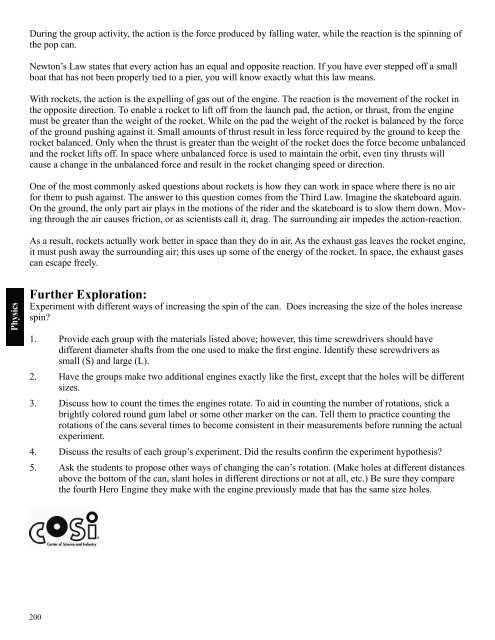ScienceMakers Toolkit Manual - The History Makers
ScienceMakers Toolkit Manual - The History Makers
ScienceMakers Toolkit Manual - The History Makers
You also want an ePaper? Increase the reach of your titles
YUMPU automatically turns print PDFs into web optimized ePapers that Google loves.
Physics<br />
During the group activity, the action is the force produced by falling water, while the reaction is the spinning of<br />
the pop can.<br />
Newton’s Law states that every action has an equal and opposite reaction. If you have ever stepped off a small<br />
boat that has not been properly tied to a pier, you will know exactly what this law means.<br />
With rockets, the action is the expelling of gas out of the engine. <strong>The</strong> reaction is the movement of the rocket in<br />
the opposite direction. To enable a rocket to lift off from the launch pad, the action, or thrust, from the engine<br />
must be greater than the weight of the rocket. While on the pad the weight of the rocket is balanced by the force<br />
of the ground pushing against it. Small amounts of thrust result in less force required by the ground to keep the<br />
rocket balanced. Only when the thrust is greater than the weight of the rocket does the force become unbalanced<br />
and the rocket lifts off. In space where unbalanced force is used to maintain the orbit, even tiny thrusts will<br />
cause a change in the unbalanced force and result in the rocket changing speed or direction.<br />
One of the most commonly asked questions about rockets is how they can work in space where there is no air<br />
for them to push against. <strong>The</strong> answer to this question comes from the Third Law. Imagine the skateboard again.<br />
On the ground, the only part air plays in the motions of the rider and the skateboard is to slow them down. Moving<br />
through the air causes friction, or as scientists call it, drag. <strong>The</strong> surrounding air impedes the action-reaction.<br />
As a result, rockets actually work better in space than they do in air. As the exhaust gas leaves the rocket engine,<br />
it must push away the surrounding air; this uses up some of the energy of the rocket. In space, the exhaust gases<br />
can escape freely.<br />
Further Exploration:<br />
Experiment with different ways of increasing the spin of the can. Does increasing the size of the holes increase<br />
spin?<br />
1. Provide each group with the materials listed above; however, this time screwdrivers should have<br />
different diameter shafts from the one used to make the fi rst engine. Identify these screwdrivers as<br />
small (S) and large (L).<br />
2. Have the groups make two additional engines exactly like the fi rst, except that the holes will be different<br />
sizes.<br />
3. Discuss how to count the times the engines rotate. To aid in counting the number of rotations, stick a<br />
brightly colored round gum label or some other marker on the can. Tell them to practice counting the<br />
rotations of the cans several times to become consistent in their measurements before running the actual<br />
experiment.<br />
4. Discuss the results of each group’s experiment. Did the results confi rm the experiment hypothesis?<br />
5. Ask the students to propose other ways of changing the can’s rotation. (Make holes at different distances<br />
above the bottom of the can, slant holes in different directions or not at all, etc.) Be sure they compare<br />
the fourth Hero Engine they make with the engine previously made that has the same size holes.<br />
200










